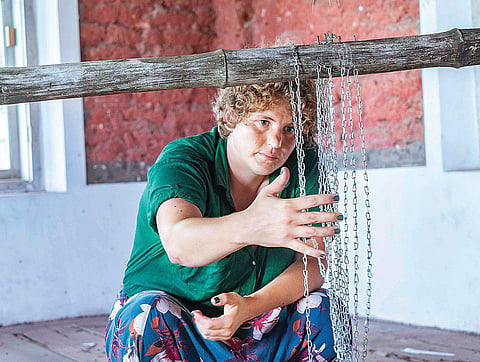

One person’s noise sometimes becomes music for other. Berlin-based sound artist Lisa Premke found that rhythm while walking on the streets of Fort Kochi. And Lisa was so overwhelmed by the cadence of the sounds that she decided to come up with a sound installation. “There were so many sounds: the noisy exhaust of an autorickshaw, the blaring horns of vehicles, and loud conversations among people in different languages.
And this was followed by the muezzin’s call for prayer from the local mosque,” says Lisa, who was in Kochi as part of a two-month residency programme under the Goethe-Institut, Bengaluru, in collaboration with Kochi Muziris Biennale, in September to create an art work.
Done at the Pepper House Studio, at first, the installation—made by hanging long chains on bamboo rods across the hall—looks like an asymmetrical one. But as the breeze blows through the windows, the chains sway creating a tinkling sound, which soothes the mind. When one observes the sounds with eyes closed, it seems like the patter of raindrops falling on asbestos sheets and sometimes like the sound of glass breaking into pieces.
In her own way, Lisa created a unique sound work, which will be installed at Kochi Muziris Biennale in December.It was in the coastal Krala city that Lisa heard some different sounds for the first time. But the most unique sound she heard was through an excursion. One night, she, along with a friend, went into the backwaters and recorded the sounds of thousands of frogs as they let out their once-a-year mating cry. “It was like a choir of animals,” she says.
Lisa got fascinated by sounds at an early age. On being asked what led to her interest in it, she says it has something to do with her childhood in Hanover, Germany. “There were distinct seasons, so in summer you could hear the sounds of birds, but this stopped in winter when the snow fell and the temperatures went to 14°Celsuis. So, I used to end up doing active listening.”
But in Kochi, Lisa says, sounds are not singular, and this is what captivated her. “Instead, they were all mixed up, and because of the humidity, the sounds carried long and far. But since the buildings did not have sleek surfaces—most had crevices, concrete walls, and green moss—the sounds did not bounce back, and entered everywhere. I would compare it to an early morning fog. It does not get on my nerves, but it’s rather calming,” says Lisa, who has done her master’s in sound from the Glasgow School of Arts.
Meanwhile, when asked to compare the sounds of Kochi and Berlin, Lisa says, “The sound in Kochi is like when you play music on the sound system while working. You get used to the constant background noise. In terms of sound, Berlin is quiet.”